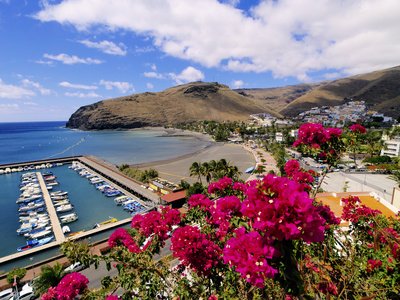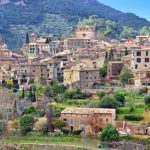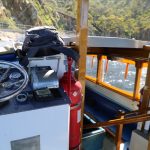La Gomera: Island of whistling wind and whistling people.
La Gomera, the second smallest of the Canarian Islands, is an island rich in culture, food and history. Some travelers believe that the nearly perfect round shape of the island helps to concentrate a lot of positive energy in this place. Whether this is true or just a cross between Chinese “Feng-Shui” and “New Age Beliefs” doesn’t really matter. What really matters though, is that La Gomera is a place remote enough to renew your soul and yet popular enough that you’ll meet travelers from all over Europe. You can hang out in bars on the coast and listen to the waves and the wind whistling in the palm trees during the days and you will even find places that serve you until early in the morning. I have been to La Gomera several times, and I highly recommend it.
This is how to get there: Fly to Tenerife, which is another Canarian island, and then take a taxi from the Airport to the ferry which crosses to La Gomera. The ferry ride from Los Cristianos, Tenerife to San Sebastian on La Gomera takes just about half an hour. Make sure you arrive during the day as the ferry does not operate all night. On the passage you may be lucky enough to see dolphins which sometimes accompany the ferry to La Gomera. Once on La Gomera you can either take a taxi and ask the driver to take you to Valle Gran Rey, which is a beautiful Valley, or you can rent a car from the car rental company, which is right at the ferry terminal. Ask them whether you have to return the car at the station in San Sebastian, or whether you can return it in Valle Gran Rey instead. The choice is yours, as the price of a taxi to Valle Gran Rey and the price of a one day car rental are about the same.
At Valle Gran Rey, you’ll find plenty of places to stay. If your journey has tired you, and you prefer to simply enjoy the ride across the island, then take a taxi to near the port of Valle Gran Rey and then have a beer or a coffee in one of the bars. The people who work in the bars will be able to help you find a place to stay, as they are all very friendly. The Canary Islands is a food lovers paradise. They grow their own bananas, tomatoes, and pineapples, and everything is extremely fresh and certainly has never seen the inside of a greenhouse. The avocadoes are sometimes as big as an American football. The best time to visit there is in winter after the first of January, because that’s the time when the flights get cheaper and most of the tourists who spend their time on the island for Christmas holidays are leaving. At that time, there are usually many lodging vacancies.
On the 5th of January the Spaniards celebrate their Christmas, and at that time they have small festivals going on and it’s really interesting to watch or to even participate. On one of these days, they burn a big model of a fish (sardine)and all of the men are dressed in women’s clothes. Also, each year around this time there are several processions. The Canarians carry a statue of Mary down from the church to the harbor.
During this time of the year the weather is not too hot, as sometimes it’s windy, and this makes La Gomera a good place for walking or biking (you can rent bikes in Valle Gran Rey). Bring good hiking shoes and you’ll love exploring the mountains and valleys. As you proceed from ridge to ridge, the vegetation is constantly changing. On one side of the mountain you might see cactuses and yet on the other side there might be lush green meadows.
In the middle of the island you’ll find a wonderful forest, which appears as if it’s straight out of a fairy tale, with moss hanging from the branches of each tree. This is the way the forest captures water out of the air. The clouds sometimes reach down to the hills and up in the mountains it is always cooler and sometimes even raining, even while it’s still sunny on the beach.
There are many beaches, which amazingly all have black sand. This is because the island was formed by volcanic action. Swimming is possible but the waves of the Atlantic here are powerful, so you should be a good swimmer. In winter it’s better to choose a place to stay that is closer to the beach, as it can be cool and humid in the mountains and the owners of the apartments there usually have no heating system.
When planning a walking trip make sure to visit “Casa Epifimia” in Las Hayas. This is the place to order the authentic gomerian “Gofio”, which tastes like mashed potatoes, but is made from roasted wheat and corn flour. Mostly served with watercress soup it is a unique vegetarian meal. The meals are always freshly prepared here. So expect that it will take some time until you are being served. Other things you might want to try is the locally made goat cheese or “Almogotre”, a spread made from the fresh cheese by adding olive oil, pepper, tomatoes and garlic. Just don’t expect to find T-Bone Steaks on the menu.
The Gomerians offer fish, goat, and rabbit meat. Too they have a unique way they boil their potatoes. They use seawater which has even more salt added to it. They then boil the potatoes in a pot only half filled with the salty water, so that when served, the potatoes have a salty crust on their skin. Also, you should try the locally produced honey and maybe even take a few jars of it home. I find it to be the most unique honey in the world, perhaps due to the flowers the bees feed from.
When you are shopping in the small supermarkets, the people running each shop will remember you after your first visit, and you’ll find they love to chat. It’s a good chance to brush up on your Spanish and learn something about the Gomerian history. Gomera was the place where Christopher Columbus replenished his food supplies before setting out to the New World.
Another specialty of the Gomerians is a whistling-language they have developed to communicate from one mountaintop to the other. The people who looked after the goatherds used this language, similar to how the Bavarians “yodeled”. This language is being taught in some schools now, as the Gomerians feel they should not let it die out. Ask the elders; you might find someone who can teach you whistling.








Leave a Reply